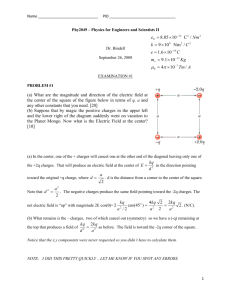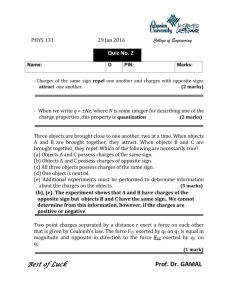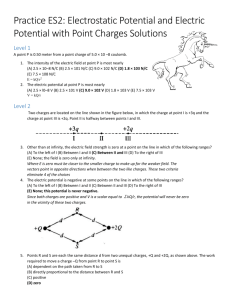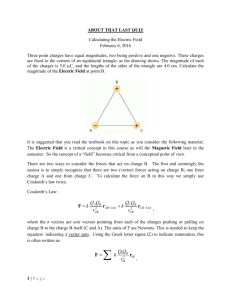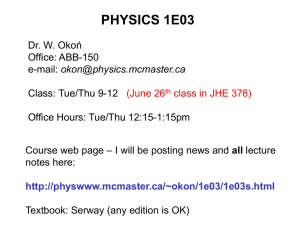Level 1
advertisement
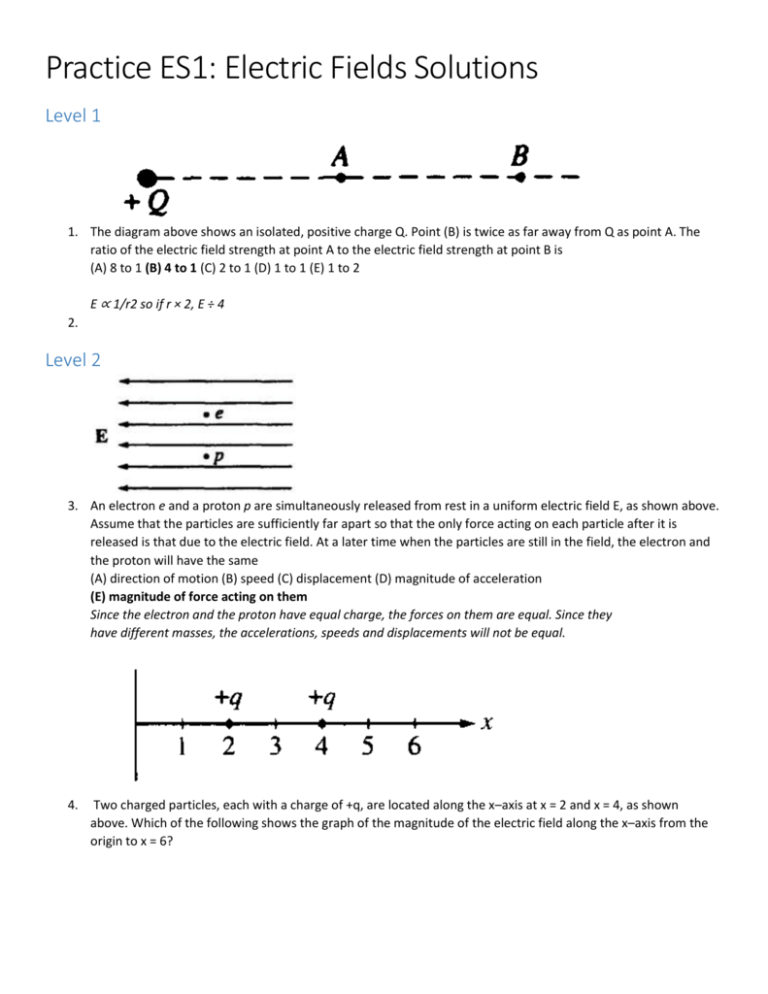
Practice ES1: Electric Fields Solutions Level 1 1. The diagram above shows an isolated, positive charge Q. Point (B) is twice as far away from Q as point A. The ratio of the electric field strength at point A to the electric field strength at point B is (A) 8 to 1 (B) 4 to 1 (C) 2 to 1 (D) 1 to 1 (E) 1 to 2 E ∝ 1/r2 so if r × 2, E ÷ 4 2. Level 2 3. An electron e and a proton p are simultaneously released from rest in a uniform electric field E, as shown above. Assume that the particles are sufficiently far apart so that the only force acting on each particle after it is released is that due to the electric field. At a later time when the particles are still in the field, the electron and the proton will have the same (A) direction of motion (B) speed (C) displacement (D) magnitude of acceleration (E) magnitude of force acting on them Since the electron and the proton have equal charge, the forces on them are equal. Since they have different masses, the accelerations, speeds and displacements will not be equal. 4. Two charged particles, each with a charge of +q, are located along the x–axis at x = 2 and x = 4, as shown above. Which of the following shows the graph of the magnitude of the electric field along the x–axis from the origin to x = 6? 5. A positive charge +Q located at the origin produces an electric field E0 at point P (x = +1, y = 0). A negative charge –2Q is placed at such a point as to produce a net field of zero at point P. The second charge will be placed on the (A) x-axis where x > 1 (B) x-axis where 0 < x < 1 (C) x-axis where x < 0 (D) y-axis where y > 0 (E) y-axis where y < 0 For the E field vectors to point in opposite directions, point P must lie outside the two charges. For the magnitudes of E due to each charge to cancel, Point P must be closer to the smaller charge Jedi 1. The following configurations of electric charges are located at the vertices of an equilateral triangle. Point P is equidistant from the charges. 2. In which configuration is the electric field at P equal to zero? (A)A (B) B (C)C (D) D (E) E E points away from + charges and toward – charges. Use symmetry. 3. In which configuration is the electric field at P pointed at the midpoint between two of the charges? (A)A (B) B (C)C (D) D (E) E D and E are not symmetric so the field will not point at the midpoint of any side. The field in choice B points at the bottom charge. Practice ES2: Potential Level 1 1. How much work is required to move – 24 mC of charge 4.0 m parallel to a uniform 6.0 N/C electric field? (A) 1.0 mJ (B) 16 mJ (C) 36 mJ (D) 62 mJ (E) 576 mJ W = Fd = qEd A point P is 0.50 meter from a point charge of 5.0 × 10 –8 coulomb. 2. The intensity of the electric field at point P is most nearly (A) 2.5 × 10–8 N/C (B) 2.5 × 101 N/C (C) 9.0 × 102 N/C (D) 1.8 × 103 N/C (E) 7.5 × 108 N/C 3. The electric potential at point P is most nearly (A) 2.5 × l0–8 V (B) 2.5 × 101 V (C) 9.0 × 102 V (D) 1.8 × 103 V (E) 7.5 × 103 V Level 2 Two charges are located on the line shown in the figure below, in which the charge at point I is +3q and the charge at point III is +2q. Point II is halfway between points I and III. 4. Other than at infinity, the electric field strength is zero at a point on the line in which of the following ranges? (A) To the left of I (B) Between I and II (C) Between II and III (D) To the right of III (E) None; the field is zero only at infinity. Where E is zero must be closer to the smaller charge to make up for the weaker field. The vectors point in opposite directions when between the two like charges. These two criteria eliminate 4 of the choices 5. The electric potential is negative at some points on the line in which of the following ranges? (A) To the left of I (B) Between I and II (C) Between II and III (D) To the right of III (E) None; this potential is never negative. Since both charges are positive and V is a scalar equal to ΣkQ/r, the potential will never be zero in the vicinity of these two charges. 6. Points R and S are each the same distance d from two unequal charges, +Q and +2Q, as shown above. The work required to move a charge –Q from point R to point S is (A) dependent on the path taken from R to S (B) directly proportional to the distance between R and S (C) positive (D) zero (E) negative By symmetry VR = VS so ΔVRS = 0 and W = qΔV Jedi This guy is difficult. Let me know if you find an easy way to solve it. I looked for an easier way with no luck. 7. Two charges, –2Q and +Q, are located on the x–axis, as shown above. Point P, at a distance of 3D from the origin O, is one of two points on the positive x–axis at which the electric potential is zero. How far from the origin O is the other point? (A) 2/3 D (B) D (C) 3/2 D (D) 5/3 D (E) 2D The points where V = 0 must lie closer to the smaller charge. Unlike electric field vectors which also require the individual vectors point in opposite directions, there are a locus of points (in this case in a ring surrounding the +Q charge) where V = 0 as the two charges are opposite in sign and V is a scalar. So the other point on the x axis is between the two charges, but closer to the +Q charge. This must be a value between 1.5 D and 2 D Answer: A By symmetry, all the vectors cancel Answer: D W = qΔV = +Q(Vcenter – V∞) = +QVcenter where Vcenter = ΣV = ΣkQ/r = 6kQ/R

